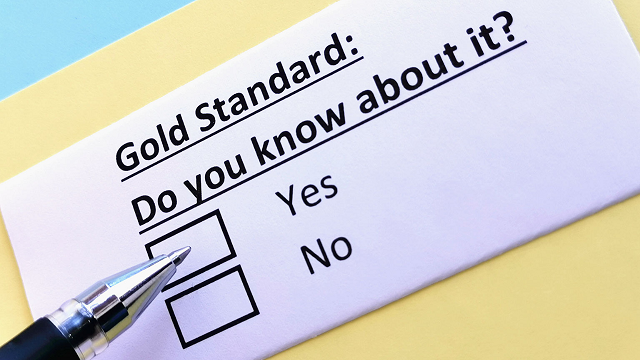Applied Behavior Analysis (ABA) therapy is widely considered to be the gold standard for autism treatment. You can Google “ABA” and “gold standard” and get pages of results. That’s because ABA therapy for autism has been studied for decades and possesses the largest body of research supporting any autism treatment. Let’s examine more closely what’s behind the “gold standard for autism treatment” label and how ABA therapy came to be so highly regarded.
Concise History of How ABA Therapy Became the Gold Standard for Autism Treatment
ABA therapy is one of the most established and specialized treatments offered to a child with Autism Spectrum Disorder (ASD) today. The science behind Applied Behavioral Analysis was founded in 1968 and has over 40 years of research to support its effectiveness in managing the symptoms of autism. Neurodevelopmental studies support the claim that children with access to early, intensive ABA therapy achieve enormous gains in development. By applying the principles of ABA therapy to behavioral challenges, ABA professionals change their clients’ lives for the better.
Because ABA focuses on communication, academics, social skills, and social functioning simultaneously, the behavior changes it teaches last over time, across environments, and into adulthood. The ultimate goal of ABA therapy is to remove or decrease the autistic client’s need for specialized services. The idea is to teach people with autism how to function independently so they can pursue their dreams and interests.
ABA Therapy and the Gold Standard for Autism Treatment Mentality
What adds to ABA’s reputation as the gold standard for autism treatment is that it aims to increase an autistic child’s ability to learn from their environment, establish relationships, and increase opportunities for independence. These are all important aspects of functioning in the world. ABA focuses on improving social interaction, increasing reasoning ability, promoting leisure time, and learning daily living skills. In addition, ABA methods help to reduce behaviors that hinder learning.
Challenges Targeted by ABA Therapy
While autism can bring about specific challenges related to communication and interaction, this developmental disorder is not without treatment options. Board Certified Behavior Analysts (BCBAs) and Registered Behavior Technicians (RBTs) are the two most common types of ABA therapists who work directly with autistic children. Treatment can be in a group setting or on a one-to-one basis. Sessions can occur at home or any place where learning will occur.
Here are some of the autism challenges that these therapists can address:
- Avoiding eye contact
- Preferring to be alone
- Showing little or no interest in others or having trouble relating to others
- Failing to understand or recognize others’ feelings or lacking the ability to express feelings
- Aversion to being touched or held
- Repeating words or actions such as rocking, spinning, or flapping arms
- Clinging to routine and having trouble with transitions or disruptions in schedules
- Strong sensitivity to tastes, smells, and sounds
ABA Therapy and Your Child
Every child diagnosed with autism is unique; not all require the same combinations of therapies to make progress. In ABA therapy, a custom treatment profile is designed by BCBAs based on the autistic person’s needs and strengths. ABA therapy will put your child’s independence at the forefront of their experience. The goal is to fade out support over time so that these individuals can live whole, independent, and joyful lives.
Outcomes of ABA Therapy
Many types of therapy assert that their treatment improves outcomes for individuals on the spectrum. With ABA being the gold standard for autism treatment, it is the first treatment recommended by medical professionals following a diagnosis of Autism Spectrum Disorder. The therapeutic processes used by BCBAs are individualized to ensure your child is meeting specific goals. What is essential to one child may be meaningless to another. This is another way ABA therapy is not a one-size-fits-all solution.
The daily living skills that ABA therapy targets, especially for younger autistic children, include:
- Dressing
- Using the bathroom independently
- Communication
- Cognitive skills
- Social skills
- Play skills
The earlier ABA therapy is put into place, the more substantial the improvement of the child’s long-term outcomes.
ABA therapy can also actively reduce challenging behaviors that can affect the quality of life for children and their families. Many children with autism have difficulty coping with transitions and tolerating changes to their routine. Others may exhibit severely restrictive eating and sleeping habits. Autistic children may also display physical behaviors that pose safety concerns for themselves and others.
The Role of Parents in ABA Therapy
A parent must be involved in therapy for the ultimate success of ABA treatment. Parents must understand that their parental behavior and choices influence their child’s behavior outcomes. A focused ABA treatment plan will target specific behaviors that need to be reduced in an effort for the child to have an improved quality of life. Family involvement is essential for the successful outcome of an ABA treatment.
The child must put newly learned skills from ABA into practice across settings and among different people in their lives. ABA therapy will change how your child responds to the world, but it will also change how you parent.
What Is Involved in ABA Therapy Sessions?
Treatment may include imaginative play, practicing independent requests, exploring, and labeling emotions. Clients may learn how to walk, hold up a peace sign, or even order a few slices of pizza. When designing a plan, BCBAs work with the family to determine what is most valuable and beneficial for the client to target. Some tasks may seem repetitive, but the idea is that the action will become second nature to the learner. These tasks may include reciting their mother’s cell number or asking for the bathroom pass during a pause.
How Many Hours of ABA Therapy Is Standard?
Treatment is typically delivered intensively for about 20-40 hours weekly. This timeframe is most commonly considered a comprehensive ABA program. Your BCBA and ABA center will perform a complete evaluation to determine how many hours will most benefit your child. Their analysis will include your child’s behavioral history and medical documentation. The treatment hours recommended by your BCBA are intended to close the gap between where the child is functioning compared to their peers. Not all children will be prescribed the maximum number of hours of treatment.
It is crucial not to judge the number of hours as good or bad. They are just a path to improvement. These hours work for you, never against you. While it may seem like a massive change to everyday living, the ultimate goal is not to need ABA therapy any longer. While it is a part of your life, ask questions, get curious, and learn as much as you can! Encourage siblings, cousins, and grandparents to do the same.
What Does ABA Therapy Look Like to the Observer?
ABA therapy is a formal behavioral treatment that involves positive reinforcement. It decreases the severity of harmful behaviors and replaces them with more helpful ones. You can expect to see the encouragement of appropriate behaviors and discouragement of behaviors that hinder learning.
RBTs will reinforce helpful and proper behaviors by applying a reward system. The reward system is generally straightforward. When the child engages in acceptable behavior as prescribed by the BCBA, the child is given a reward. The reward can be a snack, special toy, or playtime, to give a few examples. The process is repeated until the behavior becomes second nature. BCBAs will also work to find what motivates your child. Motivation is an essential component of ABA therapy. Sessions should be fun and rewarding every time!
While the reward system will typically be consistent, it is vital to be mindful that no two children diagnosed with autism are the same. With that said, no two ABA treatment plans will be the same. The BCBA assigned to your case will individualize your treatment plan to your child’s strengths and agreed-upon goals.
What’s the Overall Intended Result of ABA Therapy?
ABA therapy builds on skills related to independence to help a child be more successful in life. Just being a kid comes with its fair share of challenges, from going to school, creating friendships, getting good grades, and behaving appropriately. These challenges can be amplified tenfold for a child with autism. ABA therapy functions to make the world easier to process for your child.
The Gold Standard for Autism Treatment at ABA Centers of America
If you have received a diagnosis of Autism Spectrum Disorder for your child and you’re researching ABA therapy, it’s worth consulting with a specialist. Call ABA Centers of America at 844-923-4222 for a free, no-obligation consultation. Or message us for more information.
Learn about what to expect and how ABA therapy can help your family. Remember, ABA therapy can improve every area of a child’s life, making all the difference for them. ABA is indeed the gold standard for autism treatment and your best option if you’re looking for an insurance-covered, evidence-based, scientifically established, proven therapy.







